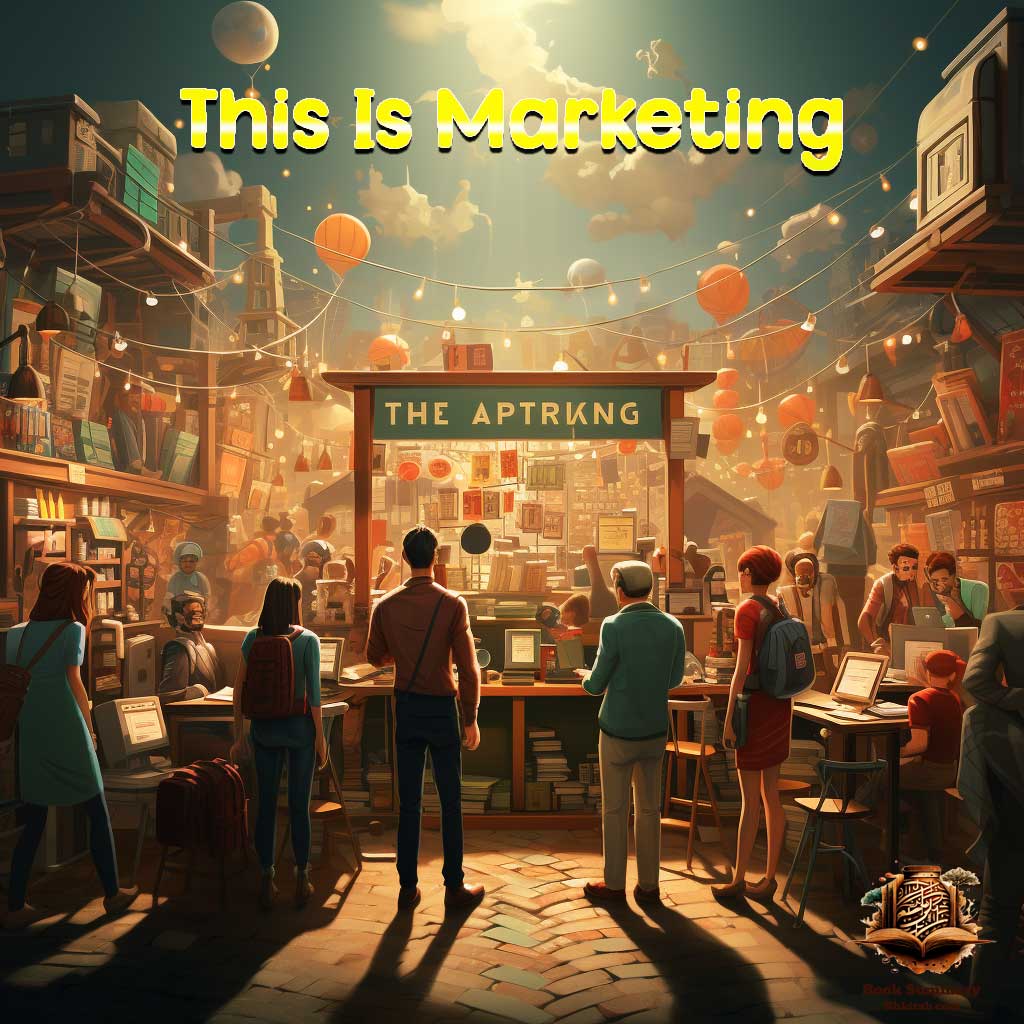This Is Marketing: You Can’t Be Seen Until You Learn to See Book Summary

Seth Godin’s “This Is Marketing: You Can’t Be Seen Until You Learn to See” stands out as a seminal work in contemporary marketing literature. Godin surpasses traditional notions of marketing merely as a tool for promoting products and services, introducing an innovative perspective that emphasizes marketing as a means of making genuine impacts and catalyzing positive change.
In this book, Godin redefines marketing as more than just a selling or promotion process. It’s an art of understanding others, discerning their desires, and offering solutions that meet their needs and aspirations. He underscores the significance of empathy and listening in the marketing landscape, asserting that true success is rooted in building sincere and meaningful relationships with audiences.
By presenting real-world examples and pragmatic advice, Godin invites marketers to reassess their strategies and tactics, encouraging them to think outside the box for optimal outcomes.
In conclusion, “This Is Marketing” is not just a guide to best marketing practices; it’s a call to perceive marketing as a medium for effecting positive change in the world. If you’re seeking a fresh and profound understanding of marketing’s role in the modern era, this book promises to be an invaluable resource.
إقرأ أيضا:كيف غير السكر العالم: رحلة عبر التاريخ من الحقول إلى الثورات والعلمHow Does “This Is Marketing” Highlight the Role of Empathy in Modern Marketing Strategies?
Seth Godin’s influential book, “This Is Marketing: You Can’t Be Seen Until You Learn to See,” delves deeply into various aspects of contemporary marketing, but one theme that stands out prominently is the role of empathy. In a digital age saturated with content, advertisements, and brand messages, Godin posits that true marketing success hinges on the ability to genuinely understand and connect with the feelings and needs of the audience.
Empathy, as highlighted in the book, is not merely about sympathizing with potential customers; it’s about deeply comprehending their worldviews, challenges, aspirations, and motivations. It’s the marketer’s responsibility to listen attentively, engage authentically, and craft messages that resonate on a personal and emotional level. In doing so, brands not only create loyal customers but also foster brand advocates who feel genuinely understood and valued.
Moreover, Godin emphasizes that marketing should not be seen as a mere transactional activity. Instead, by integrating empathy, businesses can transform their marketing strategies into impactful narratives and solutions that address real-world concerns and desires. This not only differentiates a brand in a crowded marketplace but also builds lasting relationships based on trust and mutual respect.
In essence, “This Is Marketing” underscores that in the vast ocean of market strategies, tactics, and tools, empathy is the compass that should guide every marketer. It’s the bridge that connects businesses to their audiences, creating lasting bonds and driving meaningful engagement. By emphasizing empathy, Godin shifts the paradigm from sales-centric to human-centric marketing, marking a transformative approach in the industry.
Business & Finance Management – Book Summary (khkitab.com)
How Does “This Is Marketing” Redefine Success Through the “Smallest Viable Market” Concept?
Seth Godin’s “This Is Marketing: You Can’t Be Seen Until You Learn to See” presents a groundbreaking perspective on modern marketing tactics. One of its pivotal concepts is the “Smallest Viable Market,” which challenges the conventional wisdom of mass marketing.
Instead of casting a wide net and hoping to appeal to everyone, Godin introduces the idea of zeroing in on the smallest group that could sustain a business: the smallest viable market. This means understanding this group intimately, catering to its specific needs, and building a brand or product around what truly resonates with them. By doing so, businesses can ensure a dedicated, loyal customer base rather than a dispersed and disengaged audience.
The beauty of the smallest viable market is its potential for genuine connection. When brands shift their focus to serving a niche passionately and authentically, they foster deeper relationships. They no longer shout into the void, hoping to capture anyone; instead, they engage in meaningful dialogues with an audience that feels seen and understood.
Furthermore, this approach aligns perfectly with the digital age, where personalized experiences are not only appreciated but expected. The vast expanse of the internet allows niche groups to gather, discuss, and share – making it more feasible for businesses to find and serve these tight-knit communities.
In summary, “This Is Marketing” offers a transformative lens for businesses. By emphasizing the smallest viable market, it encourages brands to prioritize depth over breadth, leading to more genuine engagements and, ultimately, a more sustainable business model in today’s hyper-connected world.
Our Facebook Page – Book Summary
How Does “This Is Marketing” Elevate the Power of Storytelling in Building Trust and Engagement?
Within the realm of contemporary marketing, Seth Godin’s “This Is Marketing: You Can’t Be Seen Until You Learn to See” identifies storytelling as a potent tool for brands and marketers. Rather than just selling a product or service, Godin articulates the profound impact of constructing compelling narratives that genuinely resonate with a target audience.
Godin’s emphasis on storytelling is rooted in the idea that people don’t merely buy products; they invest in stories, beliefs, and values associated with them. A compelling narrative provides context, evoking emotions and allowing the audience to form a personal connection with a brand. This connection is not merely transactional; it’s emotional and psychological. When brands craft narratives that mirror the aspirations, challenges, and values of their audience, they don’t just promote a product; they foster a relationship.
Moreover, in “This Is Marketing,” storytelling is underscored as a pathway to building trust. In a saturated market, where consumers are often overwhelmed with choices, a well-told story can serve as a beacon, differentiating a brand and making it more memorable. Trust isn’t built overnight. It’s cultivated over time, and storytelling provides a consistent touchpoint, allowing brands to communicate their vision, mission, and values transparently.
Furthermore, Godin elaborates that stories foster engagement. When audiences see themselves reflected in a brand’s narrative, they are more likely to engage, share, and advocate for the brand. It becomes less about the product and more about the shared journey, the shared ethos, and the shared vision.
In summation, “This Is Marketing” propounds that the essence of effective marketing today isn’t about pushing products but about telling authentic stories that echo the sentiments of the audience. Through storytelling, brands can navigate the complex waters of the modern market, building trust, fostering genuine engagement, and establishing lasting relationships.
How Does “This Is Marketing” Emphasize the Role of Genuine Value Over Product Pushing?
In “This Is Marketing: You Can’t Be Seen Until You Learn to See,” Seth Godin presents a paradigm shift, emphasizing the pivotal role of creating genuine value in contemporary marketing strategies. At its core, the book challenges the traditional sales-driven methods and propels the notion that true marketing isn’t about pushing products, but about understanding and addressing the real needs of the audience.
Godin’s perspective underscores that today’s discerning consumers are not merely seeking products; they’re searching for solutions. In a digitally connected era, where information is at the fingertips and choices are abundant, consumers are drawn to brands that offer more than just a product – they are enticed by brands that understand their genuine needs, pain points, and aspirations. It’s about building solutions that resonate, make life easier, or bring joy.
The idea of creating genuine value is also intertwined with trust. When brands prioritize the audience’s needs over their sales goals, they cultivate an atmosphere of trust. This kind of relationship-driven marketing ensures a deeper connection, fostering brand loyalty that transcends the occasional purchase. Godin argues that in the long run, this loyalty reaps more significant rewards than any short-term sales spike.
Moreover, the book highlights that creating genuine value requires an intimate understanding of the audience. This means conducting thorough market research, actively listening to customer feedback, and continually adapting to the changing dynamics of the market. It’s about proactive engagement and iteration, ensuring that the value offered remains relevant and beneficial.
In summary, “This Is Marketing” provides a fresh perspective on the essence of modern marketing. By championing the importance of genuine value, Godin suggests a more human-centric approach, emphasizing the need to enrich lives and address real-world problems over mere product promotion. In a crowded market, it’s this genuine value that sets a brand apart, ensuring sustainable growth and a dedicated customer base.
How Does “This Is Marketing” Champion the Approach of Permission Marketing Over Interruption Tactics?
Seth Godin’s “This Is Marketing: You Can’t Be Seen Until You Learn to See” redefines the landscape of modern marketing with a central emphasis on “Permission Marketing.” This concept, contrasting with traditional interruption-based methods, centers on the premise that genuine engagement arises when customers actively choose to listen, rather than being constantly bombarded with unsolicited information.
At its core, permission marketing, as elaborated in “This Is Marketing,” is about establishing respect between brands and consumers. In a world teeming with information overload, consumers value their attention more than ever. Interruption tactics, such as unsolicited ads and emails, often alienate potential customers. On the contrary, permission marketing invites consumers into a voluntary relationship, offering them relevant content and solutions they’ve expressed interest in.
Godin posits that this shift from interruption to permission doesn’t just lead to higher engagement; it nurtures trust. When brands seek permission, they communicate that they value the consumer’s time and choice. This reciprocal respect often transforms casual interactions into loyal relationships. It’s a testament to the belief that marketing is a two-way street, with both parties benefiting from genuine interactions.
Furthermore, the book elucidates that permission marketing is inherently sustainable. While interruption methods might offer temporary spikes in engagement, they rarely lead to long-term loyalty. Permission-based strategies, however, are rooted in consistent, meaningful content that serves the needs and interests of the audience, ensuring that they return time and again, deepening the brand-consumer relationship.
In conclusion, “This Is Marketing” paints a vivid picture of the evolving dynamics of the marketing world, underscoring the significance of permission marketing. By actively seeking engagement rather than forcing it, brands position themselves not just as sellers, but as valuable partners in a consumer’s journey, catering to needs with authenticity and respect.
How Does “This Is Marketing” Highlight the Power of Tribes in Building Strong Brand Communities?
In “This Is Marketing: You Can’t Be Seen Until You Learn to See,” Seth Godin delves deep into the notion of ‘tribes’ and the pivotal role they play in modern marketing landscapes. Moving beyond traditional demographics, Godin focuses on the emotional connection consumers have with brands, emphasizing the potential of harnessing these connections to build powerful, dedicated communities.
The essence of a ‘tribe’, as detailed in the book, is a group of people connected through a shared idea, passion, or mission. These are not just ordinary followers; they are evangelists, champions of the brand or cause, driven by genuine passion. In the digital age, where physical boundaries no longer limit communities, the ability to cultivate and mobilize such tribes gives brands an unprecedented edge.
Godin’s perspective on tribes underscores a shift from mass marketing to niche marketing. It’s not about reaching everyone but about deeply connecting with the right ones. These dedicated followers or ‘tribe members’ often become the most vocal advocates for the brand, amplifying its message and fostering organic growth.
Furthermore, “This Is Marketing” highlights the symbiotic relationship between brands and their tribes. It’s not a one-sided affair. While brands offer value, purpose, or a sense of belonging to their tribe, the tribe, in return, offers loyalty, feedback, and authentic engagement. This mutual exchange solidifies the bond, ensuring long-term brand growth and sustainability.
Community-building, as Godin portrays, is more than just amassing followers. It’s about fostering genuine relationships, understanding the aspirations of the tribe, and delivering consistent value. In a world cluttered with fleeting digital interactions, the tribes provide a sense of continuity and purpose.
In conclusion, “This Is Marketing” emphasizes that in today’s fragmented market, the power of tribes and community-building can’t be understated. By understanding, nurturing, and collaborating with these dedicated communities, brands can forge deeper connections, ensure brand loyalty, and drive sustainable growth.
How Does “This Is Marketing” Address the Role of Status and Dominance in Shaping Consumer Behavior?
In “This Is Marketing: You Can’t Be Seen Until You Learn to See,” Seth Godin unravels the intricacies of human behavior, particularly highlighting the compelling roles of status and dominance in determining our purchasing decisions and brand affiliations. These aspects of our psyche, often rooted deeply in evolutionary biology, play pivotal roles in shaping our interactions in modern marketplaces.
Status, as Godin elucidates, isn’t just about luxury or high-end purchases. It’s a reflection of where individuals perceive themselves in the social hierarchy. People are constantly in pursuit of products, services, or experiences that elevate their perceived status, whether within a broader societal context or a specific niche community. For instance, a rare collectible might offer status within a group of enthusiasts, even if it’s not valuable in the mainstream market.
Dominance, on the other hand, relates to the instinctual drive to be at the top, to be seen as a leader or an authority. This can manifest in the brands we choose, aiming to reflect a sense of superiority or exclusivity. It’s not just about the best product, but the perception that aligning with a certain brand or product puts one ahead of the curve.
In the book, Godin suggests that successful marketers understand and empathize with these deeply ingrained instincts. They craft narratives and brand stories that resonate with the desires for status and dominance. It’s not about manipulation but about tapping into genuine aspirations and offering avenues for individuals to fulfill them.
Further, “This Is Marketing” emphasizes the need for authenticity. While consumers aspire for status and dominance, they are also adept at discerning genuine offerings from superficial ones. Brands that promise a false sense of status or dominance can quickly lose trust, while those that genuinely empower their customers thrive.
In essence, by recognizing and respecting the roles of status and dominance in consumer behavior, marketers can design more effective strategies, creating products and narratives that resonate deeply, foster trust, and cultivate long-term loyalty.
In conclusion, understanding the intricate dynamics of status and dominance is key to building meaningful connections in today’s market. “This Is Marketing” offers invaluable insights into these aspects, guiding brands on how to genuinely resonate with their audience’s innermost desires and drives.
How Does “This Is Marketing” Leverage Tension as a Catalyst for Consumer Action?
Within the pages of “This Is Marketing: You Can’t Be Seen Until You Learn to See,” Seth Godin underscores the profound significance of tension in the realm of marketing. He suggests that the artful use of tension can lead to forward motion, prompting consumers to not only make purchasing decisions but to become true advocates for a brand or cause.
Tension, as presented by Godin, isn’t necessarily negative. It represents the gap between where we are now and where we aspire to be, between our present state and a desired outcome. This form of tension can be equated to a rubber band being stretched: the more it’s pulled, the more urgent the desire to release or resolve it becomes.
For marketers, this concept translates into creating narratives that spotlight this disparity. Whether it’s the need for the latest tech gadget, a more efficient solution to a persistent problem, or the allure of a better lifestyle, making consumers aware of what they’re missing out on — or the tension point — can be a powerful motivator. By presenting a product or service as the solution to this tension, marketers can effectively inspire action.
Moreover, Godin discusses the importance of genuine and authentic solutions. If a product or service doesn’t genuinely alleviate the tension it claims to address, consumers will quickly become disillusioned. Authenticity is paramount, and empty promises can harm brand reputation.
But when done right, leveraging tension leads to forward motion in a consumer’s journey. They’re not just buying a product; they’re resolving a tension, moving closer to their aspirational self or desired state.
In summary, “This Is Marketing” illuminates the potent tool of tension in driving consumer action. By understanding and tapping into the inherent human desire to resolve tension, marketers can craft compelling campaigns that not only sell but also create lasting impact and brand loyalty.
How Does “This Is Marketing” Emphasize Consistency and Commitment in the Marketing Practice?
In “This Is Marketing: You Can’t Be Seen Until You Learn to See,” Seth Godin delves deep into the transformative nature of modern marketing. A significant theme that emerges from his insights is the idea of approaching marketing as a consistent, committed practice, as opposed to treating it as sporadic or disjointed efforts.
Godin illustrates that the most impactful marketing strategies are those built on the foundation of consistency. Like mastering any skill, be it playing an instrument or honing a craft, success in marketing doesn’t come from isolated, flashy campaigns but from a consistent, daily commitment. This doesn’t necessarily mean bombarding your audience with relentless messages but rather establishing a genuine connection with them, listening to their needs, and iterating based on feedback.
Moreover, in the ever-evolving landscape of the digital age, consumer behaviors and preferences change rapidly. Yet, while the platforms and tools may shift, the principle of remaining consistent in brand messaging and values should remain unwavering. A brand’s voice, values, and story should be coherent across all touchpoints, regardless of the medium or channel.
The committed practice of marketing also means taking a long-term view. Short-term wins or viral moments might bring temporary attention, but they don’t guarantee lasting brand loyalty or customer relationships. True commitment involves understanding your audience deeply, building trust over time, and being there for them consistently, not just when it’s convenient or profitable.
To sum up, in “This Is Marketing,” Godin champions the idea that for marketing to be genuinely effective, brands must show up consistently and commit for the long haul. It’s about weaving a narrative, sustaining engagements, and creating genuine value over time, rather than chasing fleeting moments of attention.
In essence, the question that marketers should ponder upon is: Are you in it for the short-lived applause or the long-term ovation?
How Does “This Is Marketing” Highlight the Importance of Purpose-Driven Brands in Today’s Marketplace?
In the modern consumer landscape, as explored in “This Is Marketing: You Can’t Be Seen Until You Learn to See” by Seth Godin, there’s a clear and evolving shift towards brands that stand for more than just profit. This movement isn’t just a fleeting trend; it’s a reflection of changing consumer values and an evolving global consciousness.
Godin emphasizes that today’s consumers are not just passive purchasers; they’re active participants in the brand narratives they choose to support. They resonate with stories and causes, seeking out brands that align with their personal values and beliefs. It’s no longer about what your product can do; it’s about what your brand stands for.
The rise of purpose-driven brands can be attributed to several factors. The digital age has ushered in an era of transparency. Consumers have access to vast amounts of information, enabling them to scrutinize a company’s practices, ethics, and values more closely than ever before. As a result, they gravitate towards brands that demonstrate genuine commitment to societal and environmental issues.
Moreover, the younger generation, notably the millennials and Gen Z, play a pivotal role in this paradigm shift. They are more socially conscious and value authenticity and sustainability over mere product functionality. For them, purchasing decisions often double as a stand on societal issues.
Godin articulates that for brands to thrive in this new ecosystem, they must look beyond traditional marketing metrics and integrate purpose into their core strategy. It’s not merely about corporate social responsibility as an add-on, but about weaving purpose into the fabric of the brand’s identity.
In conclusion, “This Is Marketing” underscores a critical transition in the branding world. Brands are no longer defined merely by the quality or utility of their products but by the larger purpose they serve in the community and the world. The key question for marketers today: What does your brand stand for beyond profit? And how are you communicating that purpose to your audience?









I am really loving the theme/design of your website. Do you ever run into any web browser compatibility issues? A small number of my blog visitors have complained about my blog not working correctly in Explorer but looks great in Firefox. Do you have any suggestions to help fix this issue?